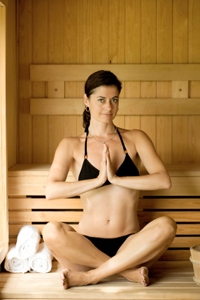 By Delia Quigley for Care2.com
By Delia Quigley for Care2.com
Ever since yoga landed on our western shores from hot and humid India some 50 years ago it has gone through quite a few transformations. New styles have emerged to shape the bodies and minds of students of all ages. Yoga is now being taught in gyms, spas, office buildings, schools, universities and private yoga studios. In these settings it is often difficult to control the temperature in the practice room, and so large numbers of yoga practitioners never get to experience the full dimension of their practice due to an air-conditioned environment.
The work of pioneering yogi Bikram Choudhury is legend amongst the yoga community. His class consists of 26 postures performed in 105-degree heat for one and a half hours. Bathing suits replace yoga clothes, towels replace rubber mats, and the squish of damp carpet underfoot becomes the background music. Bikram makes a number of claims as to the physical benefits of doing yoga under heated conditions including weight loss through improved metabolic function, detoxification of toxins through sweat, and greater flexibility in muscles and joints. In actuality it is the postures of Hatha yoga that allow for these improved conditions, while the heat is used to soften and prepare the body to stretch more deeply and without injury.
Bikram is not the only style of yoga to use heat in the classroom. Heat is the heart of any Hatha yoga practice, but too hot a temperature can also create a false sense of flexibility causing one to push tight tendons and ligaments too far, too quickly. According to Godfridev, author of Dynamic Yoga, “Hatha Yoga is a fire technique. It generates heat. Sweat should form a protective insulating coat on the surface of the body and not drop off profusely. Excessive sweating is a sign of excess liquid in the body, over exertion or both. By the time we come to the end of our practice, however, the body should be cool.”
The function of sweat is to cool an overheated body rather than remove large amounts of toxins, as is often the claim. Actually, your liver takes care of 75 percent of the body’s detoxification process, with the additional 25 percent taking place in the intestinal mucosa wall. What the twists and turns, forward and backward movements of the yoga postures do is massage the liver and intestines helping them to be more effective, while helping to push toxins out of the fat cells so they can be eliminated.
Raising the temperature in the body, whether with a yoga practice or in a sauna can help to fight off inflammation and improve immune function. This can be very important for individuals with multiple chemical sensitivity, pesticide exposure, chronic fatigue syndrome, Candida albicans, and Lyme disease. Raising the body’s internal temperatures is thought to kill off and/or subdue the yeast organisms and the Lyme spirochetes.
The movement between postures, particularly in a Vinyasa Flow style class, help raise the heart rate, oxygenating the blood, tissues and all other parts of the body. This internal heat comes from a deep place in the body radiating outwards to the skins surface. Students who have difficulty in a heated room and tend to sweat excessively find that over time this all changes. Eventually, they adapt to the heat, sweat much less and find they have more concentration, focus and internal strength then they ever imagined possible.
When attending a yoga class with a hot or even a warm room temperature drink water before and after the class to stay hydrated, bring your own mat and a hand towel to absorb any excess sweat, and layer your clothes so as not to become overheated. If your yoga space is air conditioned or cold in the winter months, ask to raise the temperature and heat the room not just for the added benefits, but for your physical safety as well.
Also Read:
